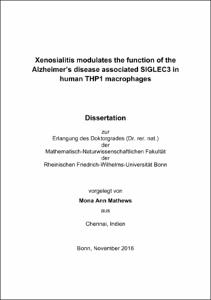Mathews, Mona Ann: Xenosialitis modulates the function of the Alzheimer’s disease associated SIGLEC3 in human THP1 macrophages. - Bonn, 2018. - Dissertation, Rheinische Friedrich-Wilhelms-Universität Bonn.
Online-Ausgabe in bonndoc: https://nbn-resolving.org/urn:nbn:de:hbz:5n-49670
Online-Ausgabe in bonndoc: https://nbn-resolving.org/urn:nbn:de:hbz:5n-49670
@phdthesis{handle:20.500.11811/7495,
urn: https://nbn-resolving.org/urn:nbn:de:hbz:5n-49670,
author = {{Mona Ann Mathews}},
title = {Xenosialitis modulates the function of the Alzheimer’s disease associated SIGLEC3 in human THP1 macrophages},
school = {Rheinische Friedrich-Wilhelms-Universität Bonn},
year = 2018,
month = mar,
note = {Chronic inflammation is an undisputed feature of late onset Alzheimer’s disease (LOAD). Activated microglia,found around amyloid beta (Aβ) plaques are implicated as the source of inflammation. However they are incapable of efficiently phagocytosing the plaques and therefore lead to Aβ accumulation. The molecular mechanisms responsible for this ambivalent and ultimately neurodestructive behavior of microglia remains elusive. Genome-wide association studies (GWAS) have identified polymorphisms of several genes, including SIGLEC3 and TREM2 found on microglia, which increase LOAD risk. Both proteins are involved either directly or indirectly with maintenance of homeostasis and phagocytosis. Therefore, it is conceivable that dysregulation of these proteins could cause inflammation and faulty phagocytosis as seen in LOAD patients.
THP1 human monocyte-derived macrophage cell line was used as a surrogate human model system to study the role of SIGLEC3 signaling. In this regard, the influence of an immunogenic sialic acid - Neu5Gc in comparison to sialic acid - Neu5Ac, serving as a ligand to SIGLEC3, on macrophage functions was analyzed. Furthermore, in order to mimic the environment of an AD brain on a molecular level, macrophages were also chronically treated with nanomolar concentrations of Aβ. The overall hypothesis of this thesis involves the comprehensive idea that chronic inflammation occurs as a result of persistently activated microglia due to improper SIGLEC3 signaling caused by Neu5Gc. The chronically malfunctioning microglia exacerbate neurodegeneration and elicits an inappropriate response to Aβ deposition. Overall, this thesis aims at determining the underlying molecular mechanisms preceding clinically diagnosed LOAD.},
url = {https://hdl.handle.net/20.500.11811/7495}
}
urn: https://nbn-resolving.org/urn:nbn:de:hbz:5n-49670,
author = {{Mona Ann Mathews}},
title = {Xenosialitis modulates the function of the Alzheimer’s disease associated SIGLEC3 in human THP1 macrophages},
school = {Rheinische Friedrich-Wilhelms-Universität Bonn},
year = 2018,
month = mar,
note = {Chronic inflammation is an undisputed feature of late onset Alzheimer’s disease (LOAD). Activated microglia,found around amyloid beta (Aβ) plaques are implicated as the source of inflammation. However they are incapable of efficiently phagocytosing the plaques and therefore lead to Aβ accumulation. The molecular mechanisms responsible for this ambivalent and ultimately neurodestructive behavior of microglia remains elusive. Genome-wide association studies (GWAS) have identified polymorphisms of several genes, including SIGLEC3 and TREM2 found on microglia, which increase LOAD risk. Both proteins are involved either directly or indirectly with maintenance of homeostasis and phagocytosis. Therefore, it is conceivable that dysregulation of these proteins could cause inflammation and faulty phagocytosis as seen in LOAD patients.
THP1 human monocyte-derived macrophage cell line was used as a surrogate human model system to study the role of SIGLEC3 signaling. In this regard, the influence of an immunogenic sialic acid - Neu5Gc in comparison to sialic acid - Neu5Ac, serving as a ligand to SIGLEC3, on macrophage functions was analyzed. Furthermore, in order to mimic the environment of an AD brain on a molecular level, macrophages were also chronically treated with nanomolar concentrations of Aβ. The overall hypothesis of this thesis involves the comprehensive idea that chronic inflammation occurs as a result of persistently activated microglia due to improper SIGLEC3 signaling caused by Neu5Gc. The chronically malfunctioning microglia exacerbate neurodegeneration and elicits an inappropriate response to Aβ deposition. Overall, this thesis aims at determining the underlying molecular mechanisms preceding clinically diagnosed LOAD.},
url = {https://hdl.handle.net/20.500.11811/7495}
}






